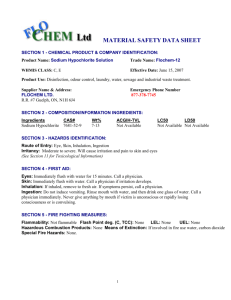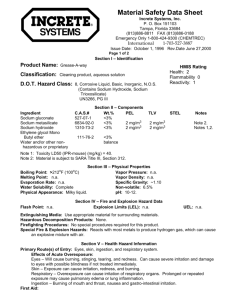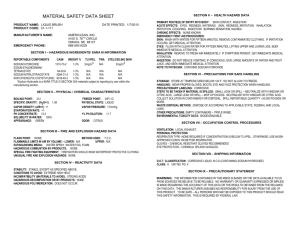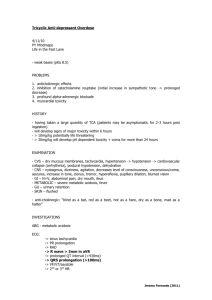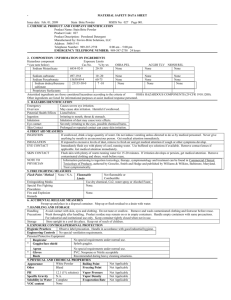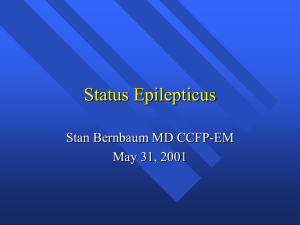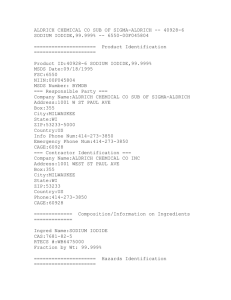g:\Documents and Settings\rothgebc\wercs.ps
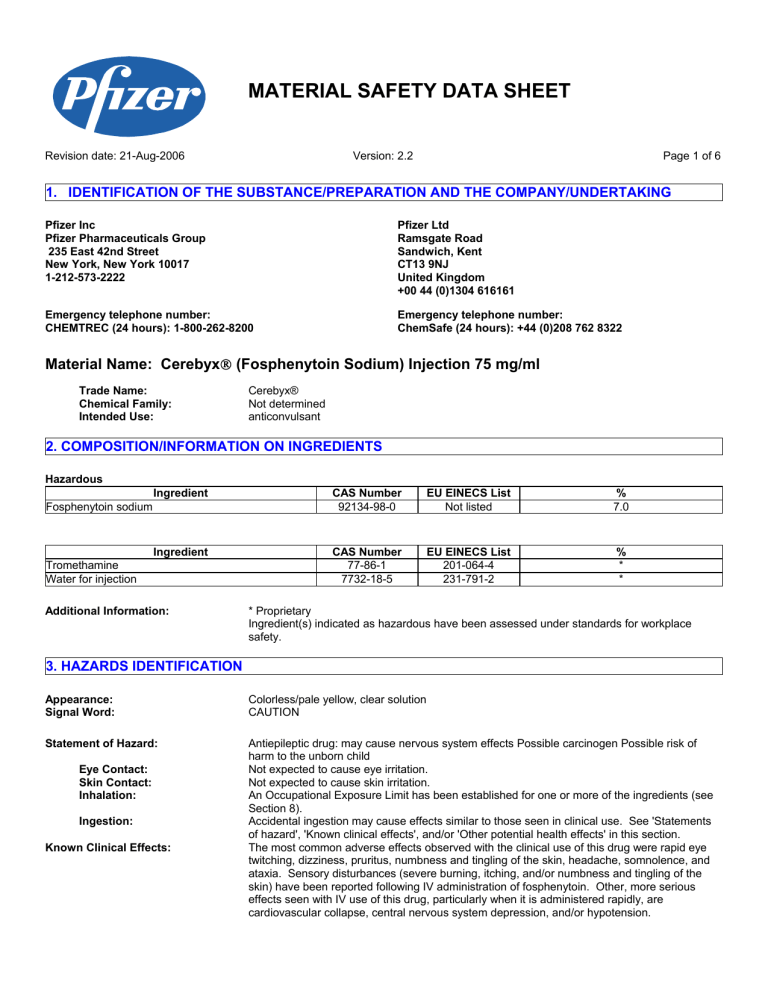
MATERIAL SAFETY DATA SHEET
Revision date: 21-Aug-2006 Version: 2.2
Page 1 of 6
1. IDENTIFICATION OF THE SUBSTANCE/PREPARATION AND THE COMPANY/UNDERTAKING
Pfizer Inc
Pfizer Pharmaceuticals Group
235 East 42nd Street
New York, New York 10017
1-212-573-2222
Emergency telephone number:
CHEMTREC (24 hours): 1-800-262-8200
Pfizer Ltd
Ramsgate Road
Sandwich, Kent
CT13 9NJ
United Kingdom
+00 44 (0)1304 616161
Emergency telephone number:
ChemSafe (24 hours): +44 (0)208 762 8322
Material Name: Cerebyx ® (Fosphenytoin Sodium) Injection 75 mg/ml
Name:
Family:
2. COMPOSITION/INFORMATION ON INGREDIENTS
Cerebyx®
Not determined anticonvulsant
Hazardous
Fosphenytoin sodium
Ingredient
Ingredient
Tromethamine
Water for injection
Additional Information:
CAS Number
92134-98-0
CAS Number
77-86-1
7732-18-5
EU EINECS List
Not listed
EU EINECS List
201-064-4
231-791-2
%
7.0
%
*
*
* Proprietary
Ingredient(s) indicated as hazardous have been assessed under standards for workplace safety.
3. HAZARDS IDENTIFICATION
Appearance:
Signal Word:
Statement of Hazard:
Contact:
Contact:
Inhalation:
Ingestion:
Known Clinical Effects:
Colorless/pale yellow, clear solution
CAUTION
Antiepileptic drug: may cause nervous system effects Possible carcinogen Possible risk of harm to the unborn child
Not expected to cause eye irritation.
Not expected to cause skin irritation.
An Occupational Exposure Limit has been established for one or more of the ingredients (see
Section 8).
Accidental ingestion may cause effects similar to those seen in clinical use. See 'Statements of hazard', 'Known clinical effects', and/or 'Other potential health effects' in this section.
The most common adverse effects observed with the clinical use of this drug were rapid eye twitching, dizziness, pruritus, numbness and tingling of the skin, headache, somnolence, and ataxia. Sensory disturbances (severe burning, itching, and/or numbness and tingling of the skin) have been reported following IV administration of fosphenytoin. Other, more serious effects seen with IV use of this drug, particularly when it is administered rapidly, are cardiovascular collapse, central nervous system depression, and/or hypotension.
MATERIAL SAFETY DATA SHEET
Material Name: Cerebyx ® (Fosphenytoin Sodium) Injection 75 mg/ml
Page 2 of 6
Revision date: 21-Aug-2006 Version: 2.2
_______________________________________________________________________________________________________
Potential Health Effects:
EU Indication of danger:
Increased frequencies of major malformations, minor anomalies, growth abnormalities, mental deficiency, and malignancies have been reported among children born to women who took phenytoin during pregnancy.
Carcinogenic: Category 3
Toxic to Reproduction; Category 3
EU Hazard Symbols:
R40 - Limited evidence of a carcinogenic effect.
R63 - Possible risk of harm to the unborn child.
Additional Information:
Note:
For a more detailed discussion of potential health hazards and toxicity see Section 11.
This document has been prepared in accordance with standards for workplace safety, which require the inclusion of all known hazards of the product or its ingredients regardless of the potential risk. The precautionary statements and warnings included may not apply in all cases.
Your needs may vary depending upon the potential for exposure in your workplace.
4. FIRST AID MEASURES
Eye Contact: Immediately flush eyes with water for at least 15 minutes. If irritation occurs or persists, get medical attention.
Skin Contact: Remove clothing and wash affected skin with soap and water. This material may not be completely removed by conventional laundering. Consult professional laundry service. Do not home launder. If irritation occurs or persists, get medical attention.
Ingestion: Get medical attention. Do not induce vomiting unless directed by medical personnel. Never give anything by mouth to an unconscious person.
Inhalation:
5. FIRE FIGHTING MEASURES
Remove to fresh air. If not breathing, give artificial respiration. Get medical attention.
Extinguishing Media:
Fire / Explosion Hazards:
Use carbon dioxide, dry chemical, or water spray.
Hazardous Combustion Products: None known or expected.
Fire Fighting Procedures: Wear approved positive pressure, self-contained breathing apparatus and full protective turn out gear.
Fine particles (such as dust and mists) may fuel fires/explosions.
6. ACCIDENTAL RELEASE MEASURES
Health and Safety Precautions:
Measures for Environmental
Protections:
Personnel involved in clean-up should wear appropriate personal protective equipment (see
Section 8). Minimize exposure.
Measures for Cleaning / Collecting: Use non-combustible absorbent material to wipe up spill and place in a sealed container for disposal. Clean spill area thoroughly.
Place waste in an appropriately labeled, sealed container for disposal. Care should be taken to avoid environmental release.
Additional Consideration for Large
Spills:
Contain the source of the spill or leak if it is safe to do so. Collect spill with a non-combustible absorbent material and transfer to labeled container for disposal.
MATERIAL SAFETY DATA SHEET
Material Name: Cerebyx ® (Fosphenytoin Sodium) Injection 75 mg/ml
Page 3 of 6
Revision date: 21-Aug-2006 Version: 2.2
_______________________________________________________________________________________________________
Additional Information:
7. HANDLING AND STORAGE
Review Sections 3, 8 and 12 before proceeding with clean up.
General Handling:
Storage Conditions:
Use with adequate ventilation. Avoid breathing vapor or mist.
Store in a refrigerated area. Vials that develop particulate matter should not be used.
8. EXPOSURE CONTROLS / PERSONAL PROTECTION
Fosphenytoin sodium
Pfizer OEL TWA-8 Hr: 0.6 mg/m³
Analytical Method:
Engineering Controls:
Fosphenytoin sodium; SAM# 172.0 (Contact Pfizer for additional details)
Engineering controls should be used as the primary means to control exposures. Local exhaust ventilation is required unless used in a closed system. For laboratory use, handle in a lab fume hood.
Personal Protective Equipment:
Hands:
Eyes:
Skin:
Rubber gloves
Safety glasses or goggles
Use protective clothing (uniforms, lab coats, disposable coveralls, etc.) in both production and laboratory areas.
If the applicable Occupational Exposure Limit (OEL) is exceeded, wear an appropriate respirator with a protection factor sufficient to control exposures to below the OEL.
9. PHYSICAL AND CHEMICAL PROPERTIES:
Physical State:
Molecular Formula:
Solution
Mixture
Color:
Molecular Weight:
Colorless to pale yellow
Mixture
Solubility: pH:
Flash Point (°C):
Boiling Point (°C):
10. STABILITY AND REACTIVITY
Soluble: Water
8.6-9.0
>61
100
Stability:
Conditions to Avoid:
Incompatible Materials:
Stable under normal conditions of use.
Avoid direct sunlight, conditions that might generate heat, and sources of ignition.
As a precautionary measure, keep away from strong oxidizers.
Hazardous Decomposition Products: None known
Polymerization: No data available
11. TOXICOLOGICAL INFORMATION
General Information: Fosphenytoin sodium is a prodrug of phenytoin and is converted to phenytoin inside the body.
The effects seen with fosphenytoin are similar to those of phenytoin.
Carcinogenicity: See below
MATERIAL SAFETY DATA SHEET
Material Name: Cerebyx ® (Fosphenytoin Sodium) Injection 75 mg/ml
Page 4 of 6
Revision date: 21-Aug-2006 Version: 2.2
_______________________________________________________________________________________________________
NTP:
IARC:
Group 2: reasonably anticipated to be a human carcinogen (Phenytoin/Phenytoin sodium)
2B: possibly carcinogenic to humans (Phenytoin/Phenytoin sodium)
Acute Toxicity: (Species, Route, End Point, Dose)
Tromethamine
Rat Oral LD50 5900 mg/kg
Fosphenytoin sodium
Mouse IV LD50 234 mg/kg
Rat IV LD50 363 mg/kg
Rat IV (bolus) LD50 319.2
mg/kg
Inhalation Acute Toxicity
Ingestion Acute Toxicity
Eye Irritation / Sensitization
Skin Irritation / Sensitization
Subchronic Effects
Chronic Effects/Carcinogenicity
No data available
No data available.
Fosphenytoin caused negligible irritation in IM and IV studies in animals. Although skin irritation has been observed in humans it is generally not seen near injection sites and should not be considered a local effect.
Hypersensitivity reactions to phenytoin and other hydantoins have been reported.
Fosphenytoin caused negligible irritation in IM and IV studies in animals. Although skin irritation has been observed in humans it is generally not seen near injection sites and should not be considered a local effect.
IV and IM studies in rats and dogs ranging from 2-13 weeks in length resulted in transient CNS effects (ataxia, decreased activity, mydriasis, and tremors) in both species. Increased liver weights, glycogen deposition, and liver enzyme changes were also seen.
Chronic toxicity studies have not been conducted with fosphenytoin. In a two-year dietary carcinogenicity study conducted with phenytoin, an increased incidence of liver tumors was seen in mice receiving 45 mg/kg/day. In the IARC monograph for phenytoin and phenytoin sodium it is also reported that oral administration of 60 mg/kg/day caused an increased incidence of thymic or generalized lymphomas in mice.
Reproductive Effects
Teratogenicity
Mutagenicity
Maternal toxicity and altered estrous cycles, delayed mating, and prolonged gestation length were observed following administration of fosphenytoin to rats during mating, gestation, and lactation at doses of 50 mg/kg or higher.
Administration of fosphenytoin sodium to pregnant rats resulted in increased frequencies of malformations (brain, cardiovascular, digit, and skeletal anomalies) death, growth retardation, and functional impairment (chromodacryorrhea, hyperactivity, circling). Doses of 75 mg/kg/day and higher resulted in increased resorption and malformation rates in rabbits. A recent epidemiological study in pregnant women found that phenytoin caused teratogenicity
(hypoplasia of the fingers) when taken alone. Due to confounding factors, such as the individuals disease state, these results are difficult to interpret. Phenytoin has been shown to cause developmental toxicity in mice, rats, rabbits, and monkeys. Effects seen include cleft lip, with or without cleft palate, shortened long bones, hydronephrosis with renal hemorrhaging, delayed ossification of the axial skeleton, neural tube defects, and cardiac, digital and ocular abnormalities.
Non-mutagenic in bacterial cells or mammalian cells. This material was not clastogenic in vivo but was positive in vitro with metabolic activation only.
Carcinogen Status: See below
12. ECOLOGICAL INFORMATION
Environmental Overview: The environmental characteristics of this material have not been fully evaluated. Releases to the environment should be avoided.
MATERIAL SAFETY DATA SHEET
Material Name: Cerebyx ® (Fosphenytoin Sodium) Injection 75 mg/ml
Page 5 of 6
Revision date: 21-Aug-2006 Version: 2.2
_______________________________________________________________________________________________________
13. DISPOSAL CONSIDERATIONS
Disposal Procedures: Observe all local and national regulations when disposing of this material.
14. TRANSPORT INFORMATION
Not regulated for transport under USDOT, EUADR, IATA, or IMDG regulations.
15. REGULATORY INFORMATION
EU Symbol:
EU Indication of danger:
Xn
Carcinogenic: Category 3
Toxic to Reproduction; Category 3
EU Risk Phrases:
R40 - Limited evidence of a carcinogenic effect.
R63 - Possible risk of harm to the unborn child.
EU Safety Phrases:
S22 - Do not breathe dust.
S36/37 - Wear suitable protective clothing and gloves.
S53 - Avoid exposure - obtain special instructions before use.
OSHA Label:
CAUTION
Antiepileptic drug: may cause nervous system effects Possible carcinogen Possible risk of harm to the unborn child
Canada - WHMIS: Classifications
WHMIS hazard class:
Class D, Division 2, Subdivision A
Tromethamine
EU EINECS List
Inventory - United States TSCA - Sect. 8(b)
201-064-4
Listed
Water for injection
EU EINECS List
Inventory - United States TSCA - Sect. 8(b)
16. OTHER INFORMATION
Reasons for Revision:
231-791-2
Listed
Updated Section 2 - Composition / Information on Ingredients.
MATERIAL SAFETY DATA SHEET
Material Name: Cerebyx ® (Fosphenytoin Sodium) Injection 75 mg/ml
Page 6 of 6
Revision date: 21-Aug-2006 Version: 2.2
_______________________________________________________________________________________________________
Prepared by: Toxicology and Hazard Communication
Pfizer Global Environment, Health, and Safety
Pfizer Inc believes that the information contained in this Material Safety Data Sheet is accurate, and while it is provided in good faith, it is without a warranty of any kind, expressed or implied.
End of Safety Data Sheet

